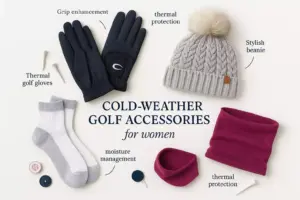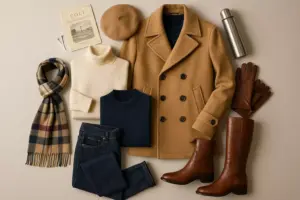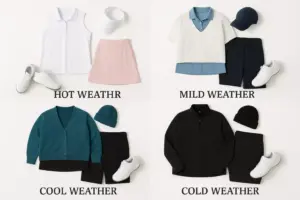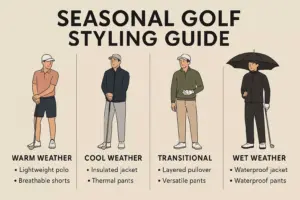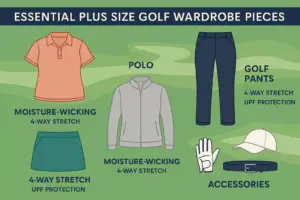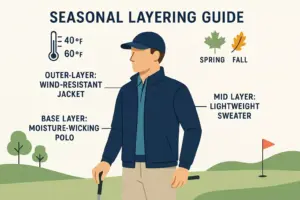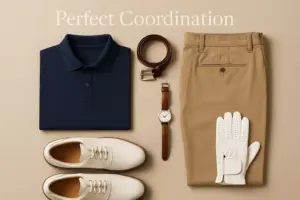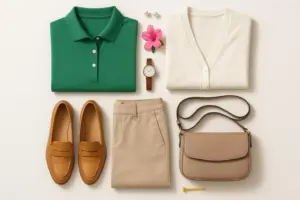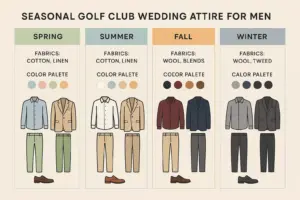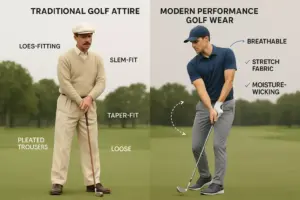The Ultimate Women’s Golf Spectator Guide: What to Wear in Cold Weather
Picture this: you’re excited to watch your favorite golfer compete in a tournament, but the forecast shows temperatures dropping to 40°F with gusty winds. Many spectators make the mistake of underdressing for golf events, only to spend hours shivering instead of enjoying the action. Cold weather golf spectatorship requires strategic planning and the right clothing choices to ensure comfort throughout the entire event.
Golf tournaments often take place in challenging weather conditions, and as a spectator, you’ll be walking long distances, standing for extended periods, and dealing with unpredictable elements. Unlike the players who generate body heat through physical activity, spectators need extra protection against the cold while maintaining mobility and style.
Key Takeaways
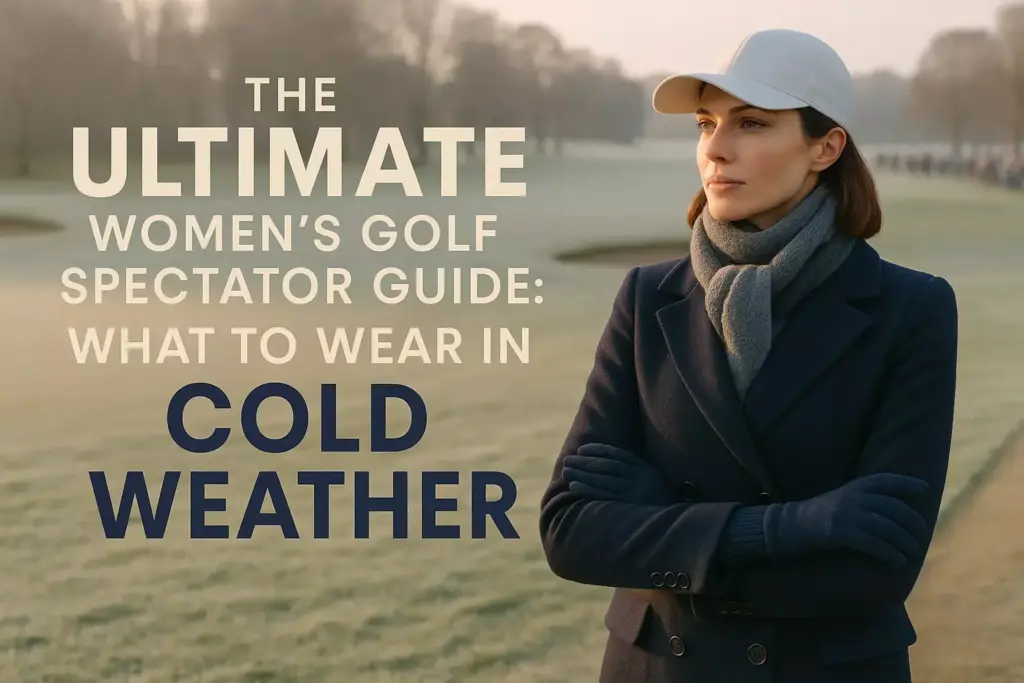
- Layer strategically with moisture-wicking base layers, insulating middle layers, and weatherproof outer shells
- Prioritize extremities by investing in quality gloves, warm hats, and waterproof footwear with good traction
- Choose breathable fabrics that allow for temperature regulation as you move between different areas of the course
- Pack essential accessories including hand warmers, portable seat cushions, and weather protection items
- Balance style and function by selecting pieces that look polished while providing maximum warmth and comfort
Understanding Cold Weather Golf Spectating Challenges
The Unique Environment of Golf Courses
Golf courses present specific challenges for cold weather spectating. Open terrain means constant exposure to wind, while walking on varied surfaces from manicured fairways to rough terrain requires appropriate footwear. The duration of events often spans 4-6 hours, making sustained warmth crucial.
Temperature Considerations
Cold weather affects the body differently during prolonged outdoor exposure. Core body temperature drops gradually, making layering essential. Extremities lose heat first, requiring special attention to hands, feet, and head coverage. Wind chill factors can make temperatures feel significantly colder than actual readings.
The Foundation: Base Layer Essentials
Moisture-Wicking Materials
The foundation of cold weather golf spectating attire starts with moisture-wicking base layers. These pieces should sit close to the skin and move perspiration away from the body.
Recommended Materials:
- Merino wool: Natural odor resistance and temperature regulation
- Synthetic blends: Quick-drying and durable
- Bamboo fiber: Soft, breathable, and naturally antimicrobial
Base Layer Options
Long-sleeve fitted tops provide coverage without bulk under additional layers. Look for seamless construction to prevent chafing during long walking periods. Thermal leggings or long underwear create a warm foundation under pants or skirts.
Building Warmth: Insulating Middle Layers
Fleece and Wool Options
The middle layer’s primary function is heat retention. Fleece jackets offer excellent warmth-to-weight ratios and maintain insulating properties even when damp. Wool sweaters provide natural temperature regulation and classic golf course style.
Vest Advantages
Insulated vests offer core warmth while maintaining arm mobility. This option works particularly well for spectators who need to frequently check phones, take photos, or handle accessories. Down vests provide maximum warmth with minimal bulk.
Weather Protection: Outer Layer Strategy
Windproof and Waterproof Options
The outer layer serves as primary weather protection. Windproof jackets prevent heat loss from wind penetration. Waterproof shells keep you dry during unexpected precipitation while allowing moisture vapor to escape.
Breathability Factors
Breathable fabrics prevent overheating when moving between different course areas. Look for ventilation zippers that allow temperature regulation throughout the day. Adjustable hoods provide head protection without compromising visibility.
Footwear: Foundation for Comfort
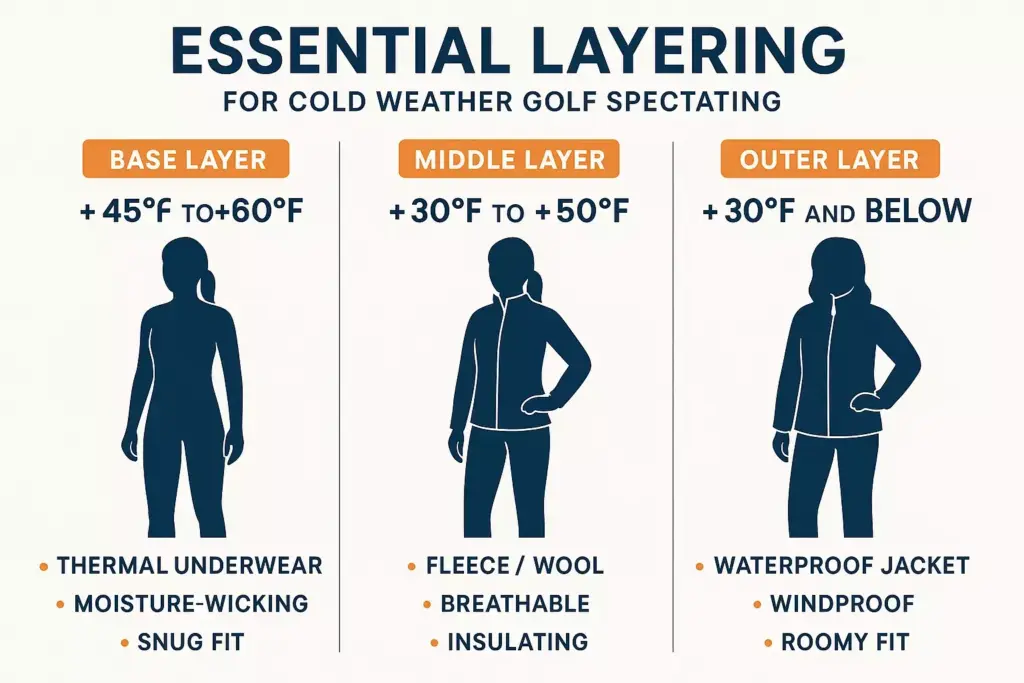
Waterproof Requirements
Waterproof boots or shoes are non-negotiable for cold weather golf spectating. Morning dew, wet grass, and potential precipitation make water protection essential. Sealed seams prevent moisture penetration.
Traction and Support
Golf courses feature varied terrain requiring appropriate traction. Rubber outsoles with deep treads provide stability on wet grass and slopes. Ankle support becomes important during long walking periods on uneven surfaces.
Insulation Options
Insulated footwear maintains foot warmth during extended outdoor exposure. Thinsulate or similar synthetic insulation provides warmth without excessive bulk. Removable insoles allow for customization and easy drying.
Protecting Extremities
Hand Warmth Solutions
Insulated gloves should allow for touchscreen compatibility while providing adequate warmth. Layering options include liner gloves under waterproof outer gloves for maximum versatility.
Hand Warmer Integration:
- Pocket-style hand warmers for continuous warmth
- Rechargeable hand warmers for extended use
- Gloves with built-in heating elements for ultimate comfort
Head and Neck Protection
Heat loss through the head can be significant in cold conditions. Warm hats or beanies should cover ears while allowing for comfortable headphone or hat use. Neck gaiters or scarves provide additional protection against wind.
Ear Protection Options
Ear warmers or headbands offer protection without disturbing hairstyles. Behind-the-neck styles work well under hats. Fleece-lined options provide comfort against skin.
Fabric Technology and Material Selection
Advanced Synthetic Materials
Modern technical fabrics offer superior performance for cold weather spectating. Polartec provides excellent warmth-to-weight ratios. Primaloft insulation maintains loft even when compressed.
Natural Fiber Benefits
Merino wool offers natural odor resistance and temperature regulation. Down insulation provides maximum warmth but requires protection from moisture. Cotton should be avoided as it retains moisture and loses insulating properties when wet.
Accessories for Enhanced Comfort
Essential Comfort Items
Portable seat cushions provide insulation from cold bleachers or ground surfaces. Thermos bottles keep beverages warm throughout the event. Blankets offer additional warmth during stationary periods.
Technology Considerations
Battery packs may drain faster in cold conditions, making portable chargers essential. Touchscreen-compatible gloves allow device use without exposure. Weather protection for electronics prevents damage from moisture.
Style Considerations for Golf Events
Dress Code Awareness
Many golf events maintain dress code standards even for spectators. Collared shirts under layers maintain appropriate appearance. Avoid overly casual items like athletic sweatshirts or workout gear.
Color Coordination
Neutral colors like navy, black, gray, and burgundy coordinate well and hide dirt from outdoor activities. Bright accents through accessories add personality while maintaining sophistication.
Professional Appearance
Tailored fits look more polished than oversized options. Quality materials maintain appearance throughout the day. Coordinated accessories create cohesive looks despite multiple layers.
Layering Strategies by Temperature Range
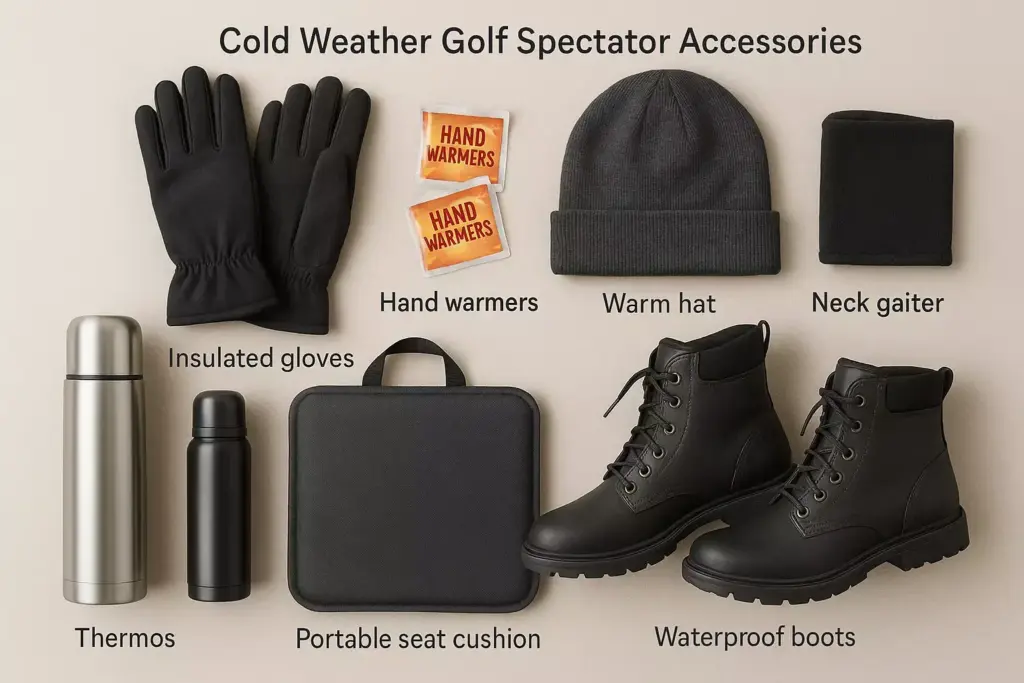
30-40°F Range
Base layer: Thermal long-sleeve top and leggings
Middle layer: Fleece or wool sweater
Outer layer: Windproof jacket
Accessories: Insulated gloves, warm hat, neck gaiter
20-30°F Range
Base layer: Merino wool or synthetic thermal set
Middle layer: Insulated vest plus fleece jacket
Outer layer: Waterproof, insulated coat
Accessories: Layered gloves, insulated hat, face protection
Below 20°F Range
Base layer: Heavy thermal underwear set
Middle layer: Down vest plus heavy fleece
Outer layer: Arctic-rated coat
Accessories: Extreme cold gloves, balaclava, multiple hand warmers
Practical Packing and Preparation Tips
Pre-Event Preparation
Weather monitoring helps determine appropriate clothing levels. Layering options provide flexibility for changing conditions. Backup items in car or bag offer security against unexpected weather changes.
Efficient Packing
Compression packing maximizes bag space for extra layers. Waterproof bags protect spare clothing and electronics. Easy access to frequently needed items improves convenience.
Event Day Strategy
Arrive early to assess actual conditions before committing to specific layers. Test mobility in full gear before walking long distances. Identify warming areas on course for potential breaks.
🏌️♀️ Cold Weather Golf Spectator Outfit Planner
Common Mistakes to Avoid
Overdressing Pitfalls
Too many heavy layers can restrict movement and cause overheating. Cotton materials retain moisture and lose insulating properties. Ignoring breathability leads to uncomfortable moisture buildup.
Underdressing Consequences
Insufficient base layers result in core temperature loss. Inadequate extremity protection causes discomfort and potential health risks. Poor footwear choices lead to wet, cold feet and reduced mobility.
Style vs. Function Balance
Prioritizing appearance over warmth often results in miserable experiences. Ignoring weather forecasts leads to inappropriate clothing choices. Forgetting backup options leaves no flexibility for changing conditions.
Budget-Friendly Cold Weather Solutions
Cost-Effective Layering
Thrift store finds can provide quality wool and fleece pieces at reduced costs. End-of-season sales offer opportunities for discounted winter gear. Multi-purpose items maximize value by serving multiple functions.
DIY Solutions
Hand warmer packets provide affordable warmth options. Layering existing pieces creates effective insulation without new purchases. Accessories from other activities like skiing or hiking often work well for golf spectating.
Investment Priorities
Quality footwear should be the primary investment for comfort and safety. Versatile outer layers provide value across multiple activities. Durable accessories like gloves and hats offer long-term use.
Health and Safety Considerations
Hypothermia Prevention
Recognizing early symptoms includes shivering, fatigue, and confusion. Maintaining core temperature through proper layering prevents dangerous heat loss. Staying dry is crucial for maintaining body heat.
Circulation Maintenance
Avoiding tight clothing that restricts blood flow to extremities. Regular movement helps maintain circulation during long stationary periods. Proper hydration supports circulation and temperature regulation.
Emergency Preparedness
Identifying warming areas on golf courses provides safety options. Carrying emergency supplies like extra hand warmers and dry socks offers security. Having exit strategies ensures ability to leave if conditions become dangerous.
Conclusion
Successfully spectating golf events in cold weather requires thoughtful preparation and strategic clothing choices. The key lies in understanding layering principles, selecting appropriate materials, and prioritizing both comfort and style. By focusing on moisture-wicking base layers, insulating middle layers, and weather-protective outer shells, spectators can enjoy tournaments regardless of temperature.
Remember that quality extremity protection often makes the difference between comfort and misery during long outdoor events. Investing in proper footwear and versatile accessories provides the foundation for enjoyable cold weather golf spectating experiences.
Take action today by assessing your current cold weather gear and identifying any gaps in your spectator wardrobe. Create a checklist based on typical weather conditions in your area, and gradually build a collection of versatile pieces that can be mixed and matched for various temperature ranges.
The investment in proper cold weather spectating attire pays dividends in comfort, enjoyment, and the ability to fully appreciate the skill and dedication of professional golfers competing in challenging conditions. With the right preparation, cold weather becomes just another element of the exciting golf spectating experience rather than an obstacle to enjoyment.

